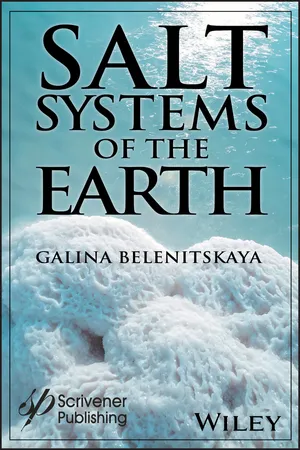
Salt Systems of the Earth
Distribution, Tectonic and Kinematic History, Salt-Naphthids Interrelations, Discharge Foci, Recycling
- English
- ePUB (mobile friendly)
- Available on iOS & Android
Salt Systems of the Earth
Distribution, Tectonic and Kinematic History, Salt-Naphthids Interrelations, Discharge Foci, Recycling
About This Book
The most comprehensive and in-depth study of the formation, practical applications, history, and natural recycling of salt, including the global and geological implications of its formative process, natural movement, and development in the Earth's subsurface.
Like water, salt is one of the most commonplace items in our everyday lives. From the omnipresent shaker that you see on every table in every restaurant, to the ocean water we swim in, salt is something that we rarely think about. But there is much more to the story of salt than most people think. Not only is salt a natural resource that must be captured and refined for public consumption, but "salt domes, " large deposits of salt that form under the ground, are important for finding and drilling for petroleum and natural gas. Salt is so important that, in ancient times, it was sometimes used as a currency in various cultures around the world, and it has been used as a food preservative, long before refrigeration was invented. Salt is something we rarely think about, but it is one of the most important natural resources that exists.
This is the first integrated study of salt's global development in the Earth's subsurface, its tectonic history and kinematic evolution, "live" salt-naphtide interconnections, and their geological recycling. The Earth's salt is shown as a peculiar umbilical thread in the analysis of numerous geological processes of salt formation, transformation, migration, discharge and regeneration, and their association with hydrocarbons. Presented here is the science of salt, including the active salt bodies' "live" in Earth's subsurface, their fate and influence over the other geological processes, including grandiose systems of kinetically interrelated allochthonous nappe-like and sub-vertical bodies formed by the migrating salt. Also included are a description of sub-conformable sheet-like salt bodies formed not by the evaporation but by emigration of buried brine-salt masses and their discharge at new, younger stratigraphic levels, a description of a phenomenon of the "halo-volcanism" due to depth breakthroughs and explosive discharges of the hydrocarbon-brine-salt masses, an examination of the over-diapir surface and brine lakes with fluctuating levels, and many other things. The book provides new interpretations of numerous issues reflecting the salt "life" manifestations and gives a key to a broad circle of the geological enigmas, from global events like the Messinian crisis in the Mediterranean to Biblical legends and enigmas of the Dead Sea-lake.
Whether you are a scientist or student working in the natural or Earth sciences, a geologist, an anthropologist, a petroleum engineer, a petrophysicist, or any other engineer or student working in petroleum engineering, this groundbreaking work is a must-have. Perfect for any scientist or engineer's library, this volume can be a must-read page-turner or a valuable reference work.
Frequently asked questions
Information
PART 1
SALTS IN EARTH’S CRUST: COMPOSITION, TECTONIC AND KINEMATIC HISTORY, SALT-NAPHTHIDE PARAKINESIS
Chapter 1
Geological-Tectonic Review of World Salt-Bearing Basins
1.1 Introduction
| Groups1 | Classes1,2 | Subclass2 | Minerals, formulae |
| 1 | 2 | 3 | 4 |
| Halogenides | Chlorides | Sodium chlorides [Na-chlorides] | Halite NaCl |
| Magnesium-potassium chlorides [Mg/K-chlorides] | Sylvite KCl Carnallite KCl·MgCl2·5H2O Bischoaite MgCl2·6H2O Tachhydrite CaCl2·2MgCl2·12H2O | ||
| Oxigen salts | Sulfates | Calcium sulfates [Ca-sulfates] | Gypsum CaSO4·2H2O Anhydrite CaSO4 |
| Magnesium-potassium sulfates [Mg/K-sulfates] | Polyhalite K2SO4·MgSO4·2CaSO4·2H2O Kainite KCl·MgSO4·3H2O Langbeinite K2SO4·2MgSO4 Kiserite MgSO4·H2O Epsomite MgSO4·7H2O | ||
| Sodium sulfates [Na-sulfates] | Tenardite Na2SO4 Mirabilite Na2SO4·10H2O Glauberite Na2SO4·CaSO4 Astrakhanite Na2SO4·MgSO4·4H2O Glaserite Na2SO4·3K2SO4 | ||
| Carbonates | Sodium carbonates [Na-carbonates] | Trona Na2CO3·NaHCO3·2H2O Nahcolite NaHCO3 Natron [native soda] Na2CO3·10H2O Northupite Na2CO3·MgCO3·NaCl Shortite Na2CO2·2CaCO3 Gaylussite Na2CO3·CaCO3·5H2O Dawsonite NaAlCO3(OH)2 Hanksite 2Na2CO3·9Na2SO4-KCl | |
| Nitrates | Potassium-sodium nitrates [K/Na-nitrates] | Nitronatrite [sodium or Chile saltpeter] NaNO3 Nitrokalite [potassium saltpeter] KNO3 |
Table of contents
- Cover
- Title page
- Copyright page
- Dedication
- Abstract
- Introduction
- PART 1: Salts in Earth’s Crust: Composition, Tectonic and Kinematic History, Salt-Naphthide Parakinesis
- PART 2: Salt in the System of Injection Formations. A Recycling Model of the Salt- and Naphthideaccumulation
- PART 3: Natural Salt Accumulation Belts and Nodes (Examples)
- PART 4: Oil and Gas Occurrence Issues in the Salt-Bearing Basins
- References
- Index
- About the Author
- End User License Agreement